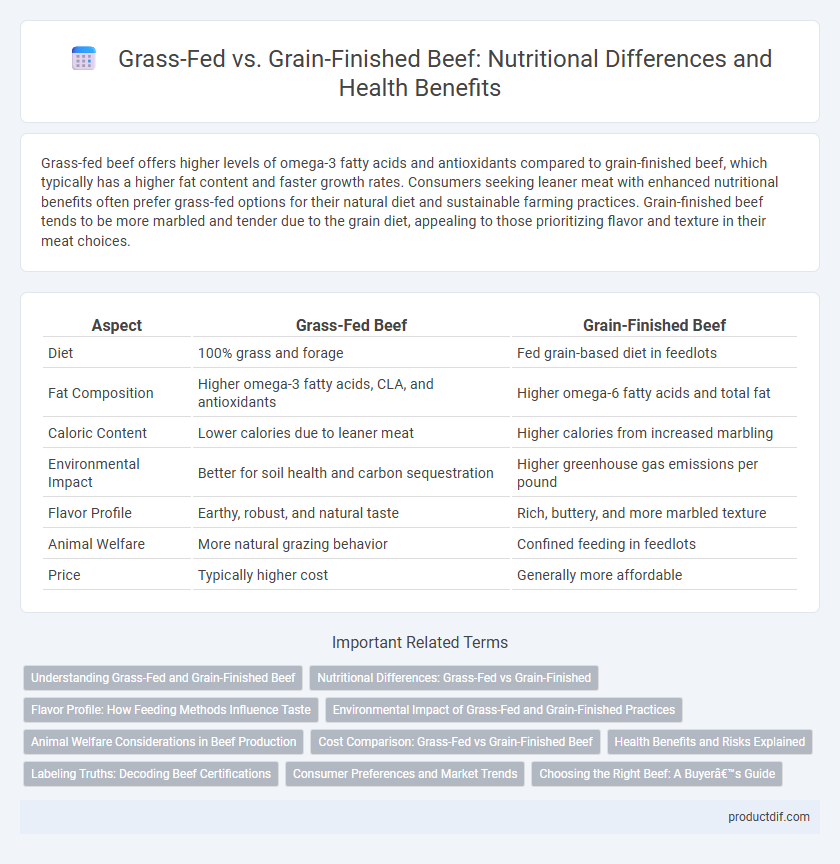Grass-fed beef offers higher levels of omega-3 fatty acids and antioxidants compared to grain-finished beef, which typically has a higher fat content and faster growth rates. Consumers seeking leaner meat with enhanced nutritional benefits often prefer grass-fed options for their natural diet and sustainable farming practices. Grain-finished beef tends to be more marbled and tender due to the grain diet, appealing to those prioritizing flavor and texture in their meat choices.
Table of Comparison
| Aspect | Grass-Fed Beef | Grain-Finished Beef |
|---|---|---|
| Diet | 100% grass and forage | Fed grain-based diet in feedlots |
| Fat Composition | Higher omega-3 fatty acids, CLA, and antioxidants | Higher omega-6 fatty acids and total fat |
| Caloric Content | Lower calories due to leaner meat | Higher calories from increased marbling |
| Environmental Impact | Better for soil health and carbon sequestration | Higher greenhouse gas emissions per pound |
| Flavor Profile | Earthy, robust, and natural taste | Rich, buttery, and more marbled texture |
| Animal Welfare | More natural grazing behavior | Confined feeding in feedlots |
| Price | Typically higher cost | Generally more affordable |
Understanding Grass-Fed and Grain-Finished Beef
Grass-fed beef comes from cattle that graze on natural pasture throughout their lives, resulting in leaner meat with higher omega-3 fatty acids and antioxidants like vitamin E. Grain-finished beef, however, involves cattle fed a diet rich in grains such as corn and soy for the final months, producing marbled meat with increased fat content and a sweeter flavor profile. Understanding these differences is essential for consumers seeking specific nutritional benefits and taste preferences in their beef choices.
Nutritional Differences: Grass-Fed vs Grain-Finished
Grass-fed beef contains higher levels of omega-3 fatty acids, conjugated linoleic acid (CLA), and antioxidants such as vitamin E and beta-carotene compared to grain-finished beef. Grain-finished beef tends to have more marbling and a higher concentration of omega-6 fatty acids, which can affect the overall omega-6 to omega-3 ratio, potentially influencing inflammation levels. Nutritional differences between grass-fed and grain-finished beef impact heart health, with grass-fed options often considered more beneficial due to their improved fatty acid profile.
Flavor Profile: How Feeding Methods Influence Taste
Grass-fed beef offers a richer, more earthy flavor with hints of herbal and grassy notes, influenced by the animal's natural diet. Grain-finished beef tends to have a milder, sweeter taste with enhanced marbling, resulting in a buttery texture and a more consistent flavor profile. These feeding methods directly impact the fatty acid composition, which alters the overall taste experience for consumers.
Environmental Impact of Grass-Fed and Grain-Finished Practices
Grass-fed beef production generally results in lower greenhouse gas emissions per acre due to enhanced soil carbon sequestration and reduced reliance on synthetic fertilizers compared to grain-finished systems. However, grass-fed cattle often require more land and longer grazing periods, which can potentially increase overall methane emissions and land use impact. Grain-finished beef tends to concentrate environmental impacts in feed crop production, involving intensive water use, pesticide application, and soil degradation, but achieves faster weight gain, potentially reducing total emissions per unit of meat produced.
Animal Welfare Considerations in Beef Production
Grass-fed beef often reflects higher animal welfare standards, as cattle graze on natural pastures allowing for more movement and natural behaviors. In contrast, grain-finished beef typically involves feedlot systems where cattle are housed in confined spaces with limited mobility, raising concerns about stress and overall well-being. Evaluating husbandry practices, such as access to open fields and diet quality, is crucial in assessing the ethical impact of these beef production methods.
Cost Comparison: Grass-Fed vs Grain-Finished Beef
Grass-fed beef typically commands higher prices due to longer raising periods and increased land requirements compared to grain-finished beef, which benefits from faster growth rates and lower feed costs. The upfront cost difference often reflects in retail pricing, with grass-fed beef averaging 20-50% more per pound than grain-finished options. Consumers seeking sustainable and organic options may justify the premium, while budget-conscious buyers often prefer the affordability of grain-finished beef.
Health Benefits and Risks Explained
Grass-fed beef contains higher levels of omega-3 fatty acids, antioxidants, and vitamins A and E, promoting better heart health and reduced inflammation compared to grain-finished beef. Grain-finished beef tends to have higher fat content and omega-6 fatty acids, which may contribute to increased risks of chronic diseases when consumed excessively. Choosing grass-fed beef supports better nutritional quality but may have a higher cost and different flavor profile.
Labeling Truths: Decoding Beef Certifications
Grass-fed beef certification ensures cattle are raised on a diet consisting entirely of grass and forage, without grain supplements, promoting higher omega-3 fatty acids and CLA levels. Grain-finished labeling indicates cattle were fed grains during the final growth phase, enhancing marbling and tenderness but potentially reducing omega-3 content. Understanding USDA and third-party certifications like American Grassfed Association or Certified Humane can help consumers verify label accuracy and make informed choices about beef quality and production methods.
Consumer Preferences and Market Trends
Consumer preferences increasingly favor grass-fed beef due to perceptions of higher nutritional value, including elevated omega-3 fatty acids and antioxidants. Market trends reveal a growing demand for grass-fed products, driven by health-conscious and environmentally aware buyers willing to pay premium prices. Conversely, grain-finished beef remains popular for its consistent marbling and affordability, maintaining a significant share of the mass market.
Choosing the Right Beef: A Buyer’s Guide
Grass-fed beef offers higher omega-3 fatty acids and antioxidants, promoting heart health and a leaner profile compared to grain-finished beef, which typically contains more marbling and provides a richer taste. Buyers seeking sustainable and ethical options often prefer grass-fed for its environmental benefits and animal welfare standards, while those prioritizing tenderness may opt for grain-finished beef. Understanding these nutritional and flavor differences helps consumers select beef that aligns with their dietary goals and culinary preferences.
Grass-Fed vs Grain-Finished Infographic

 productdif.com
productdif.com